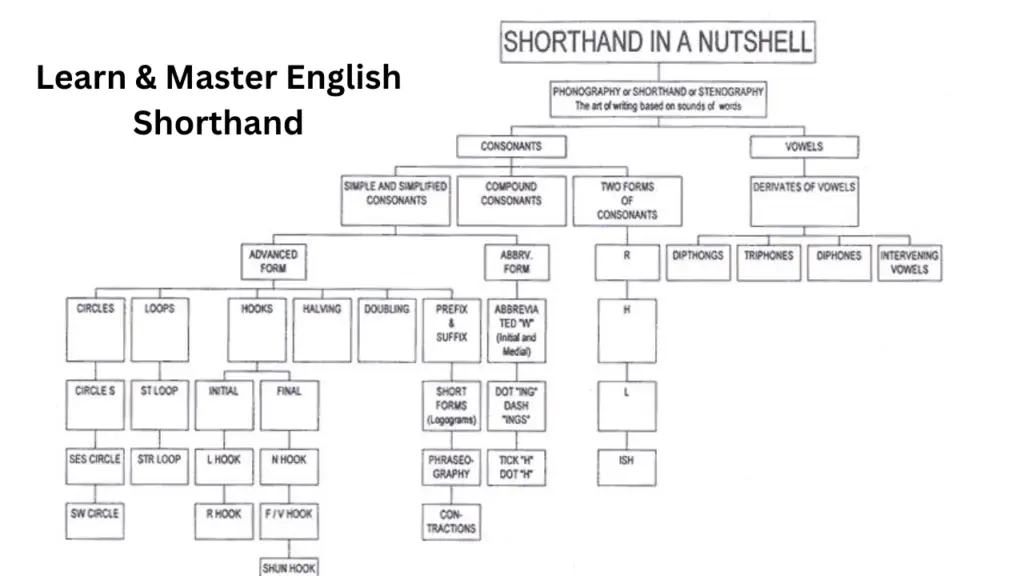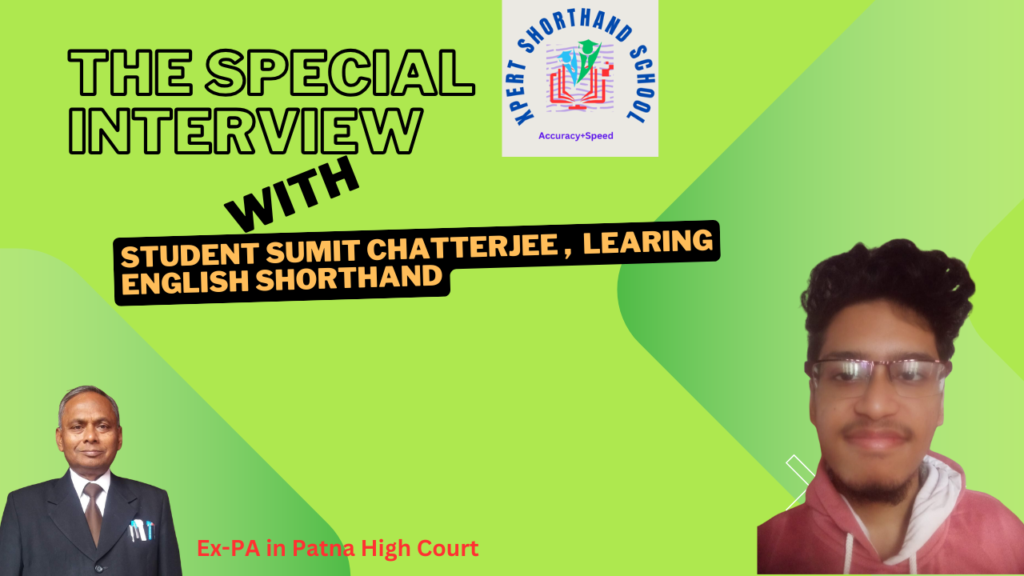Meta Description: Learn and master English shorthand in Hindi to enhance your career prospects in journalism, law, and administration. Our comprehensive training program simplifies shorthand learning with Hindi instructions, enabling you to take notes swiftly and accurately. Join now to master this essential skill and open new professional opportunities by using knowledge of learning and mastering English Shorthand writing.
Introduction
Master English Shorthand

Master English Shorthand in Hindi
In today’s fast-paced world, efficiency is key. Whether you’re a student, journalist, or government job aspirant, to master English shorthand in Hindi can provide you with an invaluable skill to take notes quickly and accurately. English Shorthand is not just about writing fast; it’s about improving your career prospects, boosting productivity, and gaining an edge over others. This guide will help Hindi-speaking learners grasp the fundamentals of learning and mastering English shorthand writing in a simplified and effective manner.

English Shorthand is a powerful skill that opens doors to career opportunities in journalism, court reporting, administration, and more. With the increasing demand for efficient note-taking and transcription, learning and mastering English Shorthand in Hindi can be a game-changer for students and professionals. This blog will explore the importance, benefits, and best practices for mastering English shorthand in Hindi, making it easier for Hindi-speaking learners to grasp this essential skill.
What is “Master English Shorthand” and Why is it Important?
Shorthand is a system of rapid writing that enables users to transcribe spoken words quickly. It has been widely used for centuries in journalism, legal proceedings, and administrative work. The ability to write at high speed without losing accuracy makes “master English shorthand writing” an essential skill for many professionals.
“Master English Shorthand” writing is important because it helps individuals take notes efficiently, ensuring they capture every detail without missing crucial information. It enhances career prospects, especially in government sectors where stenography is a highly sought-after skill. Additionally, it improves mental agility, listening skills, and concentration, making it beneficial beyond just the workplace.
In today’s digital age, shorthand remains relevant as it aids in quick documentation, improves productivity, and provides a competitive edge in various job markets. Whether you are a student, a journalist, or someone preparing for stenography exams, “master English shorthand’ can be a game-changer in your professional journey.
Shorthand is a system of rapid writing that enables users to transcribe spoken words quickly. It is widely used by stenographers, journalists, and secretaries. “Master English shorthand” helps in:
Fast and accurate note-taking – Essential for legal, corporate, and media professionals.
Career growth – Government and private sector jobs require shorthand proficiency.
Enhanced productivity – Saves time and effort in documentation and reporting.
Improved focus and listening skills – Helps professionals retain more information.
Benefits of “Master English Shorthand” in Hindi
“Master English shorthand” in Hindi offers numerous advantages, making it an ideal choice for Hindi-speaking learners. One of the biggest benefits is better comprehension—when complex shorthand rules and symbols are explained in Hindi, students grasp them more quickly and accurately. This method removes language barriers and simplifies the learning process.
Another significant advantage is increased confidence. Many learners hesitate to study shorthand due to its English terminology. However, learning it in Hindi bridges the gap, making the subject more approachable and less intimidating. It also encourages effective practice, as students can relate shorthand strokes to familiar Hindi sounds, ensuring better retention.
Additionally, “Master English shorthand” enhances career opportunities. Government exams, such as SSC Stenographer and State Secretariat jobs, require shorthand proficiency. Private sector jobs in journalism, legal transcription, and administration also value this skill. Moreover, shorthand boosts mental agility by sharpening listening and writing speed, leading to improved overall communication skills.
Overall, “Master English shorthand” in Hindi creates an easier, faster, and more effective learning experience, helping individuals excel in their careers and personal growth.?
“Master English Shorthand” in Hindi provides numerous advantages for students and professionals alike. One of the key benefits is better comprehension—when complex shorthand rules are explained in Hindi, learners grasp them more quickly. This eliminates language barriers and enhances confidence.
Another significant benefit is increased efficiency in note-taking. Shorthand enables individuals to transcribe speeches, lectures, and meetings rapidly, making it highly useful for journalists, court reporters, and office professionals. Additionally, shorthand proficiency opens doors to government jobs, as many SSC and stenographer examinations require this skill.
Moreover, learning shorthand in Hindi reduces learning time by offering clear explanations, making practice easier and more effective. Hindi-speaking students find it simpler to relate to phonetic principles when taught in their native language.
Many Hindi-speaking learners face difficulties understanding English shorthand due to language barriers. Learning shorthand in Hindi provides:
Better comprehension – Hindi explanations make it easier to grasp complex rules.
Simplified learning process – Instructions in Hindi reduce confusion and enhance clarity.
Increased confidence – Understanding concepts in your native language helps in quick learning.
Effective practice techniques – Hindi-based exercises improve retention and recall.
Popular Shorthand Systems
Pitman Shorthand – The most widely used system, based on phonetic sounds.
Gregg Shorthand – A simpler, cursive method popular in the US.
Teeline Shorthand – A modern and easy-to-learn approach.
Among these, Pitman Shorthand is the most effective for professional use in India.
How to Learn And Master English Shorthand Effectively
Learn how to “Master English shorthand” requires a structured approach and consistent practice. Here are some effective steps to help you learn shorthand efficiently:
Start with the Basics – Begin by understanding the shorthand alphabet, basic strokes, and phonetic principles. Learning the fundamental rules will set a strong foundation.
Use Hindi References – Hindi-speaking learners can benefit from bilingual resources that explain shorthand concepts in Hindi, making comprehension easier.
Practice Daily – Regular practice is essential. Start by transcribing simple words and gradually move to phrases and full sentences.
Listen and Write – Dictation exercises improve speed and accuracy. Begin with slow dictations and increase the speed over time.
Increase Speed Gradually – Aim for a speed of 30-40 words per minute initially, then progress to 80-100 wpm for professional competency.
Use Digital Tools – Shorthand learning apps and online courses can provide interactive exercises and real-time feedback.

Test Yourself Regularly – Taking frequent mock dictations and self-assessments ensures steady progress.
With dedication and the right approach, mastering English shorthand becomes easier, opening up career opportunities in various fields.
Career Opportunities After You Master English Shorthand
Once proficient as a “Master English shorthand, you can explore various career options:
Government Jobs – SSC, Railway, and Court Stenographer exams.
Journalism & Media – Reporters and editors use shorthand for note-taking.
Legal & Corporate Sector – Lawyers and executives require shorthand transcription.
Freelancing & Online Jobs – Virtual assistants and content creators benefit from this skill.
Conclusion
Thus to become “Master English Shorthand” in Hindi is a game-changer for students and professionals looking to enhance their note-taking and transcription skills. It bridges the language gap, making it easier for Hindi speakers to grasp complex shorthand principles with clarity and confidence. By learning shorthand, you not only improve your writing speed but also open doors to lucrative career opportunities in government jobs, journalism, law, and corporate sectors.
The key to success in shorthand is consistency. Regular practice, dictation exercises, and speed-building techniques will help you achieve proficiency. Starting with the basics and gradually increasing your speed ensures long-term mastery. Additionally, leveraging Hindi explanations and bilingual study materials makes the learning process smoother and more effective.
With the growing demand for stenographers and fast note-takers, acquiring shorthand skills is an investment in your future. Whether you aim for a government position or freelance transcription jobs, this skill will always be in high demand. Take the first step today, stay committed to your practice, and watch how shorthand transforms your career prospects.
Ready to begin? Join our training program and take your shorthand skills to the next level!
Frequently Asked Questions (FAQ)
Q1: What is English Shorthand, and why should I learn it?
A1: English Shorthand is a fast writing system used to transcribe spoken words quickly. It is beneficial for professionals like stenographers, journalists, and legal assistants. Learning shorthand enhances career prospects and improves note-taking efficiency.
Q2: Can I learn English Shorthand if my primary language is Hindi?
A2: Yes! Learning English Shorthand in Hindi helps Hindi-speaking learners grasp concepts more easily. Using Hindi explanations simplifies complex shorthand principles and speeds up the learning process.
Q3: How long does it take to become proficient in shorthand?
A3: The time required depends on your practice routine. With consistent effort, most learners achieve a speed of 80-100 words per minute within 4-6 months.
Q4: What are the best techniques to improve shorthand speed?
A4: Regular dictation practice, repetition of common words, and speed-building exercises are crucial for improving shorthand speed. Using bilingual study materials also helps.
Q5: What career opportunities are available after learning shorthand?
A5: Shorthand skills open doors to jobs in government offices, courts, media houses, and corporate sectors. Freelance transcription jobs are also an option.
Q6: Where can I enroll for an English Shorthand course in Hindi?
A6: You can join our online training program to learn shorthand with expert guidance and structured lessons.
